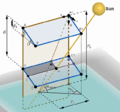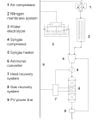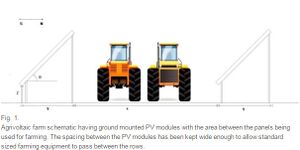
In order to meet global energy demands with clean renewable energy such as with solar photovoltaic (PV) systems, large surface areas are needed because of the relatively diffuse nature of solar energy. Much of this demand can be matched with aggressive building integrated PV and rooftop PV, but the remainder can be met with land-based PV farms. Using large tracts of land for solar farms will increase competition for land resources as food production demand and energy demand are both growing and vie for the limited land resources. This land competition is exacerbated by the increasing population. These coupled land challenges can be ameliorated using the concept of agrivoltaics or co-developing the same area of land for both solar PV power as well as for conventional agriculture. In this paper, the agrivoltaic experiments to date are reviewed and summarized. A coupled simulation model is developed for both PV production (PVSyst) and agricultural production (Simulateur mulTIdisciplinaire les Cultures Standard (STICS) crop model), to gauge the technical potential of scaling agrivoltaic systems. The results showed that the value of solar generated electricity coupled to shade-tolerant crop production created an over 30% increase in economic value from farms deploying agrivoltaic systems instead of conventional agriculture. Utilizing shade tolerant crops enables crop yield losses to be minimized and thus maintain crop price stability. In addition, this dual use of agricultural land can have a significant effect on national PV production. The results showed an increase in PV power between over 40 and 70 GW if lettuce cultivation alone is converted to agrivoltaic systems in the U.S. It is clear, further work is warranted in this area and that the outputs for different crops and geographic areas should be explored to ascertain the potential of agrivoltaic farming throughout the globe.
Method[edit | edit source]
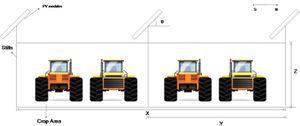
External resources for agrivoltaics[edit | edit source]
See also[edit | edit source]
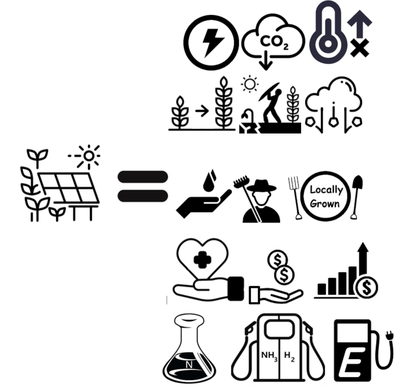
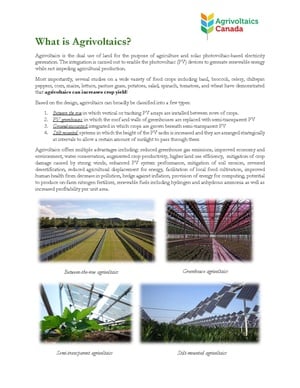
- Coal with Carbon Capture and Sequestration is not as Land Use Efficient as Solar Photovoltaic Technology for Climate Neutral Electricity Production
- Dual use of land for PV farms and agriculture literature review
- sheep
- Israeli white plastic reflectors
- A Farmer's Guide to Going Solar (NREL)
- German guidelines: https://www.ise.fraunhofer.de/content/dam/ise/en/documents/publications/studies/APV-Guideline.pdf
- 2021 review
- Miskin, C.K., Li, Y., Perna, A., Ellis, R.G., Grubbs, E.K., Bermel, P. and Agrawal, R., 2019. Sustainable co-production of food and solar power to relax land-use constraints. Nature Sustainability, 2(10), pp.972-980.
- Retrofitting solar parks for agrivoltaics
- Shading PV
- Alexis' talk at American Solar Grazing Association2021
In the News[edit source]
- Agrivoltaics: solar energy + better crops Climate and Nature
- Why solar power and farmers’ fields could be the perfect combination TVO
- Solar farms and sheep show the makings of a clean energy classic duo Business Renewables
- Agrivoltaics charge up St. Albert-area farms St Albert Gazette
- Sheep, solar and crops. How some Alberta farms are creating ideal growing conditions Western Wheel
- Sheep, solar and crops. How some Alberta farms create ideal growing conditions Voxpopuli
- 3D printed clamps for front-surface PV mounting on wood racking PV Magazine
- Harvesting the Sun to Grow in the Shade Garden Culture Magazine
- What crops fit with vertical agrivoltaics? PV Magazine
- Agrivoltaics – Keeping the farm in the solar farm Green Energy Futures
- Booming solar industry has a growing appetite for weed-chomping crews CBC
- La floreciente industria solar tiene un creciente apetito por equipos de devoradores de maleza Espanol news
- Des cochons à l’ombre des panneaux solaires, l’agrivoltaïsme gagne en popularité Radio Canada
- Pigs in the shade of solar panels, agrivoltaics gains popularity Euro Day France
- Des porcs à l’ombre des panneaux solaires, l’agrivoltaïque gagne en popularité News Day France
- ICI Radio
- The Weather Network
- Agrowoltaika zyskuje na wartości. Panele słoneczne na polu nie przekreślają upraw Business Insider Poland
- Kanada/ Coraz popularniejsza agrowoltaika: rolnictwo i produkcja energii w jednym Deon Pl
- Tu zboże, tam fotowoltaika. Rolnicy produkują i żywność i energię na jednym polu Bankier PL
- Kanada: coraz popularniejsza agrowoltaika: rolnictwo i produkcja energii w jednym MSN PL
- Agrowoltaika podbija świat (Agrovoltaics is conquering the world ) Warzywnichtow Polish
- Coraz popularniejsza agrowoltaika - rolnictwo i produkcja energii w jednym Agro Polska
- Agriculture and Energy Future - Agrivoltaics Agritecture
- MBA students examine a solar farm’s benefits for critical issues case competition Ivey
- Ontario solar curbs rankle expert BNN Bloomberg
























